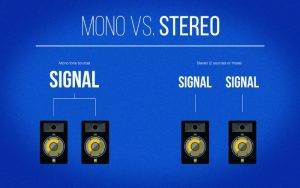Table of Contents
Audio is an integral part of our daily lives, from the music we listen to on our devices to the soundscapes in movies and TV shows. When it comes to audio, two common terms you’ve likely encountered are “mono” and “stereo.” In this comprehensive guide, we will explore the differences between mono and stereo audio, their applications, and how to make the most of each format.
Understanding Mono and Stereo

Let’s start by gaining a fundamental understanding of what mono and stereo audio mean:
Mono (Monaural):
Mono audio consists of a single channel or sound source. In a mono audio track, all audio information is combined into a single signal. When played through a single speaker or headphone, you hear the same audio in both ears.
Stereo:
Stereo audio, short for “stereophonic,” utilizes two separate audio channels or sound sources. This format provides a sense of spatial audio, where different sounds can be heard in each ear, creating a more immersive listening experience.
Mono and Its Applications
Mono audio has its own set of applications and advantages:
Clarity and Compatibility:
Mono audio is often used for voice recordings, podcasts, and radio broadcasts. It ensures that the audio is clear and easily understood, making it an excellent choice for spoken content.
Legacy Equipment:
Many older audio devices, such as vintage radios and record players, are designed for mono playback. Mono recordings remain compatible with these devices.
Center Channel:
In surround sound systems, the center channel is typically mono. It anchors dialogue and essential audio elements in movies and TV shows, ensuring they are clear and centered.
Stereo and Its Immersive Experience
Stereo audio offers a more immersive and dynamic listening experience:
Spatial Soundstage:
Stereo audio creates a sense of direction and space. When listening to music or watching movies in stereo, you can perceive the location of instruments or sound effects within the soundstage.
Music Production:
Most modern music is produced in stereo. It allows for the separation of instruments and vocals, enabling producers to craft a richer, more textured sonic landscape.
Gaming and Virtual Reality (VR):
Stereo sound is crucial for gaming and VR experiences. It enhances immersion by providing spatial cues, allowing players to locate enemies or navigate virtual worlds.
Mono vs. Stereo Recording

When recording audio, whether it’s for music, podcasts, or other content, choosing between mono and stereo can significantly impact the final result:
Mono Recording:
- Ideal for spoken word content like podcasts.
- Ensures consistent sound across all playback systems.
- Minimizes phasing issues when combining multiple microphones.
Stereo Recording:
- Captures the spatial nuances of music, natural environments, and soundscapes.
- Provides depth and dimension to audio, enhancing the listener’s experience.
- Requires careful microphone placement to achieve the desired stereo effect.
Playback Systems and Compatibility
Understanding the playback systems and compatibility of mono and stereo audio is essential:
Mono Playback:
- Mono audio can be played on both mono and stereo systems without issue.
- Some playback devices automatically combine stereo audio into mono when only one speaker or headphone is in use.
Stereo Playback:
- Stereo audio requires stereo playback systems for the full effect.
- When played on a mono system, stereo audio may lose its spatial qualities, but the core content remains audible.
Mixing and Editing Mono and Stereo Audio
Whether you’re an audio enthusiast or a content creator, knowing how to mix and edit mono and stereo audio is valuable:
Mono Mixing:
- Focus on clarity and centering the audio source.
- Ideal for eliminating background noise and ensuring a clean recording.
Stereo Mixing:
- Utilize panning to position audio elements within the stereo field.
- Pay attention to the balance between the left and right channels for a coherent soundstage.
The Future of Audio
As technology evolves, the distinctions between mono and stereo audio continue to blur:
Immersive Audio Formats:
- Emerging formats like Dolby Atmos and DTS:X offer multidimensional sound, going beyond traditional stereo and surround sound.
Spatial Audio for Streaming:
- Platforms like Apple Music and Tidal are introducing spatial audio experiences, enhancing music with three-dimensional soundscapes.
Personalized Audio:
- AI-driven audio processing allows for personalized listening experiences, adapting to individual preferences.
Mono or Stereo: Which to Choose?
The choice between mono and stereo audio depends on your specific needs:
Choose Mono When:
- Clarity and intelligibility are paramount.
- You want compatibility with older devices.
- You’re recording spoken content or a single audio source.
Choose Stereo When:
- You seek a more immersive and dynamic listening experience.
- You’re recording music, sound effects, or content with multiple audio sources.
- You want to take full advantage of modern audio technology.
Related Post:
Unlocking the Power of Wireless Microphones for PCs: A Comprehensive Guide
Shotgun Mic for iPhone: A Comprehensive Guide
Microfono para Entrevista: A Comprehensive Guide to Interview Microphones
Understanding the differences between mono and stereo audio empowers you to make informed decisions when recording, mixing, and enjoying audio content. Whether you’re preserving the clarity of spoken words in mono or immersing yourself in the spatial richness of stereo, both formats have their unique places in the world of sound. Embrace the diversity of audio options, and let your ears guide you to the most fitting choice for any situation. Happy listening!

